

- Call 908 543 4390
- Email
- Dr.Joni Redlich PT,DPT


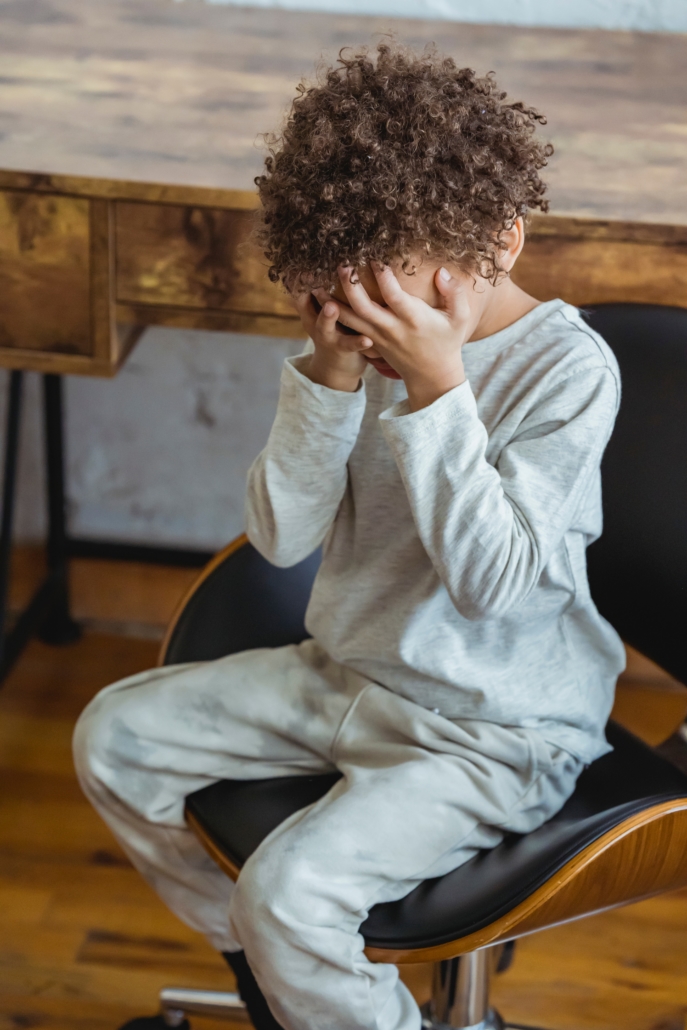
May is Arthritis month! Why are we talking about Arthritis? Well, it’s not a diagnosis that only affects adults, it affects kids too. Juvenile Idiopathic Arthritis is a diagnosis that affects kids of many ages, both young kids and older teens too. Unfortunately, Juvenile Idiopathic Arthritis (JIA) is sometimes passed off as “growing pains” by some medical professionals when a child complains of joint pain. This is seen to happen more frequently with older children or young teens complaining of joint pain because at this time in their lives, they are going through large periods of growth and physical development. Sometimes it is just growing pains, but sometimes it might not be! We wanted to give parents and therapists a guide so that you can recognize when signs and symptoms of JIA might be present and know who to seek out for help if you think your child might be showing some signs and symptoms of JIA.
JIA (also known as Juvenile Rheumatoid Arthritis), causes joint stiffness and joint swelling, also known as inflammation. JIA affects one or more joints for at least 6 weeks or more in children who are 16 years old or younger. JIA is different from Adult Rheumatoid Arthritis, because symptoms can decrease or go away completely as they get older BUT it can affect how a child’s bones develop as they grow.
JIA is an autoimmune disease. An autoimmune disease can occur when the body’s immune system becomes overactive and begins to attack its own healthy tissue. In JIA, the primary tissues that are affected are bone and cartilage around the child’s joints. When this begins to happen, it can happen chronically or episodically. If a child’s JIA symptoms are chronic, they have them most to all of the time where as if they are episodic, they may go through flare ups where their symptoms get worse and then have periods where they have no symptoms at all.
Children with JIA primarily have symptoms related to their joints like swelling, stiffness, and pain. The joints that are most commonly affected are the knees, hands, feet, ankles, shoulders, and elbows, but the spine and hips can also be involved. Pain and swelling are often at their worst in the morning or after a nap. Children can also have decreased appetite, poor weight gain, slow growth, eye inflammation, and fatigue. In systemic JIA, children can also present with a high fever, rashing, and swollen lymph nodes. The tricky thing is that some of these symptoms can seem like other illnesses or health conditions so it is important to make sure your child is seen by their primary doctor and a rheumatologist for appropriate diagnosis.
Yes, They absolutely do! Physical Therapy is essential for kids with JIA to help preserve joint function and to help strengthen the body to better support the joints. When a child has JIA, strengthening has to be done carefully so to not overstress the joints, and PTs have the expertise to help guide you and your child away from activities and sports that may be harmful for your child’s joints and toward more helpful activities. In acute phases of JIA, when your child is exhibiting a flare up of their symptoms, PT helps to maintain their joint range of motion, prevents muscles from getting too weak, and helps protect their bones from getting weak too. When your child is not experiencing a flare up of pain and stiffness, PT will help improve your child’s gross motor skills, especially ones that may have been limited due to their pain and decreased range of motion, so that they play and move with more freedom and confidence. If a child has a more chronic form of JIA, physical therapy will also help to achieve new mobility goals while making sure to keep their pain levels low and to prevent increased swelling.
If your child has a diagnosis of JIA or if you think there is a possibility they may have JIA, talk to your child’s primary care doctor about whether or not they believe JIA is a possibility and what your next steps should be. If your child is experiencing joint pain, they may benefit from physical therapy for all the reasons discussed above and more. Our therapists at KidPT can help give you more information and can take a look at your child to see if physical therapy would be an appropriate next step to help their body grow and develop in the healthiest way possible!
If you want to learn more about the different types of JIA, the process for diagnosis for JIA, and more, click to read the article below:
References:

Happy Mother’s day to all our moms. Today we celebrate the unmatched and superhuman strength of mothers. Motherhood comes in many forms from biological to adoptive to a grandparent caregiver to legal guardian to working mom to stay at home mom to single mom to military mom and so much more.
Every mother is different and has their own strengths and weaknesses, but we want to applaud you and encourage you for all you do.
Raising a child is the most vulnerable, life-giving, exhausting, and worry-filled adventure we can go on. From the extreme highs to the devastating lows, it can feel indescribable. But our legacies are the children we love and support so that they can live a life of joy and meaning.
On this Mother’s Day we are celebrating a few of the many strengths of moms. Today is a day to just honor and acknowledge who you are day in and out. No need for tips, tricks, or advice today as you are enough, mom.
Emotional Strength
You deserve to be applauded for the emotional weight you carry in your home. It can be hard to be the emotional reservoir for an entire family. It can seem that you are always worrying about something as a mom whether it’s managing their schedule, academics, nutrition, health care, transportation, sleep, etc. Sometimes the constant thoughts and the emotional weight can take a toll on you and all you can do is just sit on the couch in mental exhaustion. This is no sign of weakness when you consider the strength and endurance it requires to constantly carry and nurture your family’s needs.
Physical strength
The physical strength needed to be a mother is nothing short of extraordinary. From the physical expense of carrying a child in the womb and the physical changes that your body undergoes while nurturing your baby’s life to the physical demands of carrying, bathing, cleaning, feeding your child and managing your household. Sleep often becomes a long lost friend from sleepless nights caring for your infant to catching up on “me time” or other tasks while the kids are in bed. There is nothing like the physical strength of a mother to overcome these hurdles in order to provide for the needs of herself and her family.
Resilience
Every day comes with its own journey, victories and disappointments. Parenting is a marathon and it may feel hard to see the progress of your parenting each day. Despite this, you push on and do your best to remain hopeful and engaged. It may seem the values you are trying to teach your children are not taking root and that your efforts are ineffective. But how sweet it tastes when you are awarded little glimpses of your children practicing strategies that you have been intentionally trying to instill in them, whether it’s noticing their kindness in how they treat others or signs of their developing bravery, emotional intelligence, and self regulation. You are resilient and your children will learn to be resilient through your example. Don’t underestimate the moments when you help them conquer their fears and how you make them feel heard and understood when they are struggling. It’s all too common for mothers to look around and convince themselves that everyone else is doing life better and that other mothers always do the right thing. It’s normal to have these feelings and doubts and to perceive that your world is in chaos. It is hard to figure out which route or philosophy to take with parenting and it is easy to feel overwhelmed. Despite this negative self talk, things are going better than you imagine and your kids are thriving from your strength and resilience.
From our families to yours, we hope this Mother’s Day you feel seen, affirmed, and loved.
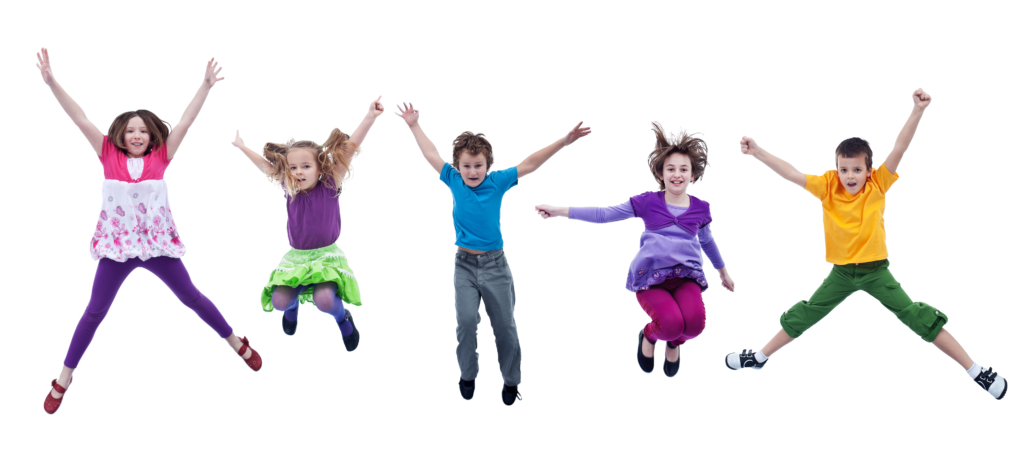
Savvy parents know that every child has their own sensory preferences and things they avoid. Whether it is picky eating, not liking the seams in socks, or having a hard time sitting still because the child’s body has the wiggles, every child has their own sensory world. Every adult has their sensory preferences too, but we learn to manage our needs by taking walks when we need to wake up a bit, chewing gum to stay focussed, or shaking our foot while listening to a speech.
Every child will have their own personal sensory profile, but when is it time to get help. When sensory preferences are impacting daily life, that’s a good time to seek help from an occupational therapist or a physical therapist.
Below we’re going to introduce the difference sensory systems and give you some tips to start figuring out what sensory strategies will help your child.
Kids who seek out rough play, jumping and/or crashing, or our kids who like to lie down on the ground a lot may need more input to this system. It helps us to sense movement and organizes our bodies to help with coordination, body awareness and spatial awareness.
TRY activities that involve:

Kids who appear to seek constant movement, are risk takers and like to be upside down may need more input to this system. Some kids may look more sedentary or lethargic and may also need some vestibular activation! This is another movement sense, it is related to our head position in space, and gives our bodies information about balance and is closely related to our visual system.
TRY activities that involve:

Kids who are constantly touching and fidgeting may need more input in this area. Kids who are extra sensitive to seams or clothing, or avoid getting messy might be on the opposite side of tactile processing. It refers to our sense of touch, and can impact all areas of function from eating to walking to feeling the nuances of toys and materials during self-care and play.
TRY activities that involve:

Kids who are constantly humming, yelling, and making other noises, they may need more auditory input than other children. Kids who zone out, seem to ignore you, or struggle to shift from one listening to another listening cue/instruction (or for example, respond to their name).
TRY activities that involve:

Kids who require more visual input may look closely at objects. They may seek out moving or spinning objects. They may have difficulty focusing on information presented visually. On the other end, lights might be too bright or the child may struggle to adjust to lighting changes, or become overwhelmed incertain lighting, like fluorescents.
TRY activities that involve:

Kids seeking out input to these systems may lick or smell objects like crayons or toys. Chewing also provides proprioceptive input, so kids may bite or chew on objects (think pencils or shirt collars). May be averse to tastes or smell, picky eaters tend to be sensitive in this area.

Links to some of our favorite sensory products:
Need some more help finding sensory savvy solutions for your child! Reach out to us at info@kidpt.com and schedule a FREE Discovery Visit with one of our therapists to learn more.
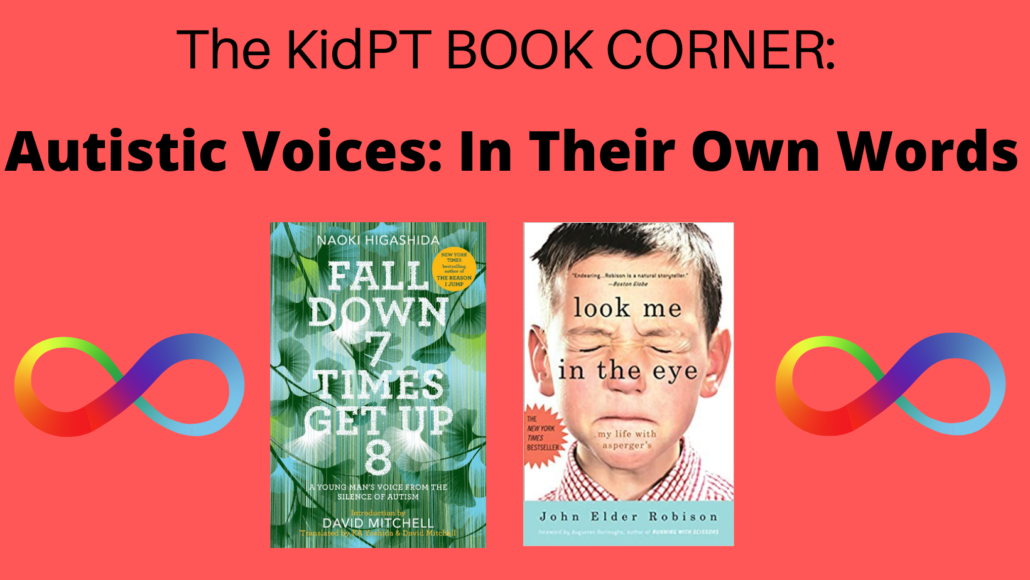
When learning about any topic, you can only learn so much from studying the academic literature. For example, if I want to understand Italy I can only learn so much from a textbook. In order to truly better understand Italy, It is vital that I actually go to Italy and experience first hand the climate, the weather, the people, the food, and the culture in varied settings and at different times of the year. Some things can’t be taught, they need to be experienced.
Why don’t we also do this with people with special needs and specifically autistic individuals?
We may learn the physiology, the outward signs and symptoms, and theories on how to address and “treat” autistic people, but we will never truly understand autism by only relying on an outsider’s perspective. It is vital to listen to autistic voices in order to better understand, support them, and create an inclusive environment.
As autism is a spectrum and no two autistic people are the same, it is important to experience the perspective of a variety of people; from those who are non-verbal to those who have more asperger-like symptoms, those who have more physical limitations to those with more cognitive impairments, and from the young to the old. With that in mind, we will be discussing two books: “Fall Down 7 Times and Get up 8” by Naoki Higashida and “Look Me in the Eye: My life with Asperger’s” by John Elder Robison.
Naoki Higashida wrote the book “The Reason I jump” at age 13 which has been translated from Japanese to over 30 languages. Through his works he has provided the world with the inner voice of a nonverbal child and now adult with severe autism. “Fall Down 7 Times, and Get Up 8” is an incredible book in which he shares wise insight, in depth descriptions of his thought processes, and also clever, creative writing. Naoki has a refreshing and enlightened outlook on life and his autistic diagnosis. He covers topics ranging from inexpressible gratitude for his family to the thought processes he uses to register what the sound of rain means to empathizing with his grandfather’s dementia. Despite the obstacles he faces as a nonverbal autistic individual, Naoki is determined to live with purpose and self love.
John Elder Robison is an autistic man born in the late 1950’s who was undiagnosed until much later in life. His book is a captivating memoir of his extraordinary life as he makes it to the big time in the music industry, the corporate world, and then owning his own car service and dealership company while finding his niche in the world as a neurodiverse individual. He discusses the challenges of not knowing why he was different from other people and repeatedly claims that his childhood and early adulthood would have benefitted from a knowledge of his diagnosis.
3 Takeaways from Both Books:
Autistics prefer to be alone: Debunked
Although it is a common trend for those with autism to isolate, that is more of a response to frustration than a desire to be alone. We all have experienced the pain of not fitting in and feeling uncomfortable in our skin and how all we wanted to do in that moment was run away. Those with autism, in self-preservation can do the same. The heart-breaking reality is that neurotypical people often grow out of this phase as they have more social tools available to them, while those on the autism spectrum, if not properly socialized and made welcome in a community, can find themselves isolated. Communication is a tool most people take for granted and underestimate. At the deepest levels of who we are, we crave to be known and to know others. It really is what life is about and autistic people are no exception. Communication is what makes that possible. John Elder says that he can’t speak for other autistics, but that he never wanted to be alone. He explains that due to repeated failure with attempts to connect with people, autistics are at risk to turn inwards and withdraw from others. Naoki describes wordlessness as a “soul crushing condition” and the loneliness is agony. But this loneliness can be interrupted as he goes on to explain that “if there is a single person who understands what it’s like for us, that’s solace enough to give us hope.” Naoki describes that just being in the presence of his family brings him comfort. He describes, “and from my face and reactions you wouldn’t know that I’m enjoying myself, but just watching my family being a family brings me great pleasure.”
Autistics want acceptance
Naoki believes that he has his positive outlook on his autism because his parents were neither in denial of his autism or limited his potential because of it. They allowed him to dream, make choices, and respected his feelings. They treated him with the expectation that he was capable of more and provided him with relevant resources. They loved, dreamed with, and accepted him. It is natural to want the best for someone with autism and try to help them or even fix them. Naoki and John Elder agree that the deeper need is not to be fixed, it is to be loved and accepted for who they are, as they are. Naoki said, ““Love and only love makes whole the heart of those made desperate by loneliness.” Naoki’s advice is simple. Do as his parents did: “please lend us that support as we strive to live in society.”
Autism is a communication disorder
Although someone with severe autism may not be able to show typical outward signs of understanding, it does not mean that they do not listen or have an inner voice that wants to communicate. Autism “may look like a severe cognitive impairment” but “it is a sensory processing and communicative impairment.” The old adage, don’t judge a book by its cover, is an important lesson to remember when spending time with someone with autism. Naoki gives us a sober insight that, “we are listening to everyone around us, & we hear you, you know.” He describes how demoralizing it can be when people speak about him as though he is not in the room. Everyone deserves to be treated with respect and dignity.
Likewise, John Elder provides insight into why interactions and conversations with neurotypical people can be challenging and why his responses and actions can often be misinterpreted as socially inappropriate. He has a gifted way of describing his logical thought process which contributes to his difficulty reading social cues, engaging in small talk, and interpreting the intention behind the words of others. He explains that sometimes people have less compassion for him because there is no outward sign of his conversational handicap, but instead see him as arrogant or psychologically unstable. He suggests that with a deeper and broader understanding of the autism spectrum, the general public will be able to create a better and more inclusive environment for the neurodiverse.
To those of you reading this who communicate often with someone with autism, I want to encourage you. Yes, this is difficult, yes we will make mistakes, and yes, at times our frustration can get the best of us. But we need to remember that even if we don’t say or do the right thing all the time, the important thing is we love, respect, and accept autistic people for who they are.
Referenced below are the books covered and others like it.
References:
“Fall Down 7 Times, and Get Up 8.” Naoki Higashida, KA Yoshida, and David Mitchell
“Look Me in the Eye: My Life with Aspergers.” John Elder Robeson’s Book,
Further Reading:
“The Reason I Jump.” Naoki Higashida, David Mitchell, and Keiko Yoshida
“Carly’s Voice: Breaking through Autism.” Arthur and Carly Fleischmann
“How Can I talk if My Lips Don’t Move? Inside My Autistic Mind.” Tito Rajarshi Mukhopadhyay
“Born on a Blue Day: Inside the Extraordinary Mind of an Autistic Savant.” Daniel Tammer
“Pretending to be Normal: Living with Asperger’s Syndrome.” Liane Holliday Willey
“Thinking in Pictures.” Temple Grandin

What does movement have to do with Autism, you ask? In short, EVERYTHING! Movement is the way we interact with our environment, one of the ways we make sense of all the information around us, and the way we turn our will into action! Even something that seems so based in the brain, like writing or typing our thoughts down, involves movement to actually get those thoughts onto paper or into a computer.
But what if the wiring in your brain telling your body to move a certain way wasn’t communicating that information effectively?
Or what if the information you were getting from your environment, like the sights or feelings around you were coming in as too bright, too sharp, or not clear enough?
What if you couldn’t necessarily tell where your body was in relation to your environment or where your legs and arms were while walking around?
It would be so much harder for you to get around without knocking into things, to react to your environment in the safest way, move the way you wanted, and keep your stress level down while doing all of these things, right?!
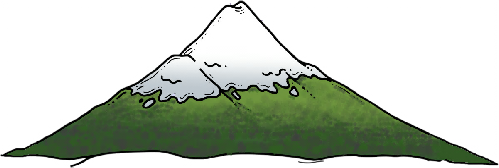 These are just some of the small or large mountains that a person with Autism needs to climb on a daily basis to feel like their normal selves and to engage with our crazy world. Movement can be overwhelming and difficult to coordinate or extra movements may be necessary to feel where their bodies are in space. With the many lenses we can look through from a therapy perspective, we often land on the tie between Autism and movement and want to discuss the connection and why children with Autism may be inclined to move more and to move in their own individual way.
These are just some of the small or large mountains that a person with Autism needs to climb on a daily basis to feel like their normal selves and to engage with our crazy world. Movement can be overwhelming and difficult to coordinate or extra movements may be necessary to feel where their bodies are in space. With the many lenses we can look through from a therapy perspective, we often land on the tie between Autism and movement and want to discuss the connection and why children with Autism may be inclined to move more and to move in their own individual way.
Movement to meet sensory needs:
Movement that is Difficult to Coordinate:
Now add extra distractions of daily life to the Mix!
These are just some of the big reasons why movement can be tricky and discoordinated in autistic children and how it can impact os many areas of daily life, from getting dressed in the morning to social interaction. We know this is A LOT of information to take in, but this connection is an important one to make because when movement is hard, it makes coping with everyday life hard and stressful! If you feel like coordinating movement or movement with other daily tasks is sometimes tricky for your child, call (908) 543-4390 or visit our website at www.kidpt.com to schedule a FREE Discovery Visit today!
Extra reads:
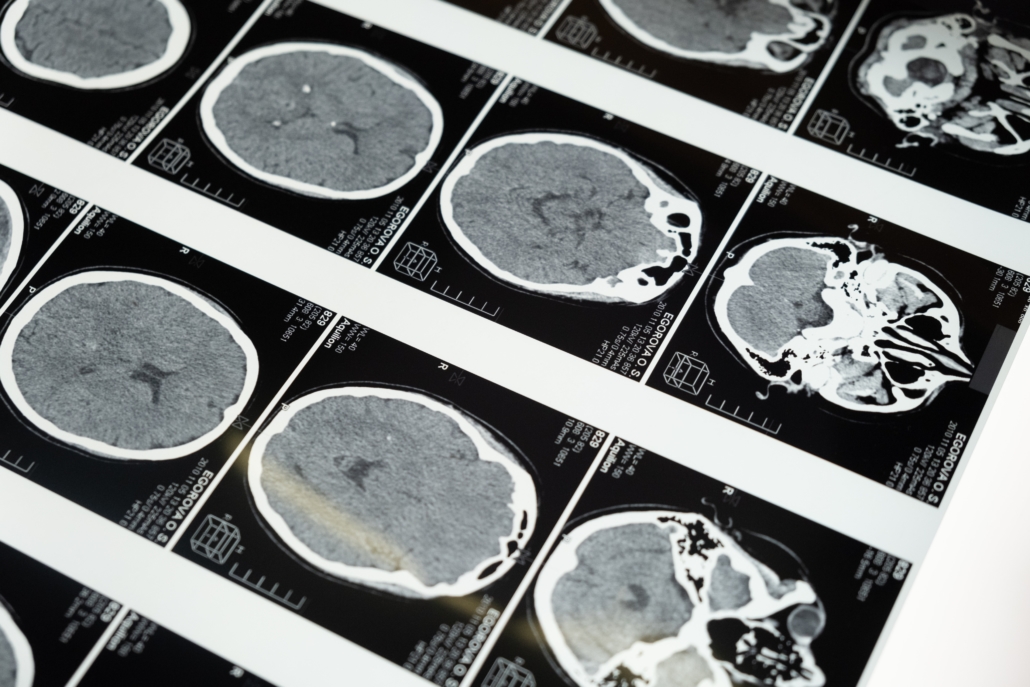
As March is also Brain Injury Awareness Month, we will be discussing concussions. Did you know that concussions are actually mild traumatic brain injuries?
Let’s unpack what actually happens during a concussion.
First of all, a concussion can result from rapid movement such as whiplash, a direct blow to the head/ face/ neck, or indirectly by a significant blow elsewhere in the body that is transmitted to the head. These forces put stress on the brain cells and can cause microdamage. Whenever there is damage to a part of the body, the body responds with inflammation, changes in blood flow, and changes in tissue chemistry. While this body response can help assist healing, it requires a high demand of energy and also reduces the amount of energy and nutrients that the brain has access to due to changes in blood supply. This places the brain in a vulnerable state as the brain has limited resources to function as it heals.
Once the brain has experienced a concussion it is more vulnerable to repeated injury. Subsequent concussions often have longer lasting and more severe symptoms, so it is important to avoid environments and activities that could expose the child to a second concussion. Therefore, it is vital to reduce the demands on the brain to allow it to rest and heal and minimize the symptoms. A concussion can impact cognitive, physical, emotional, and proper sleep function.
Some symptoms of impaired Cognitive function include difficulty concentrating, reduced short term memory, feeling in a fog, and feeling slowed down. Physical symptoms of a concussion include headaches, dizziness, fatigue, nausea, sensitivity to light, balance impairments, ringing in the ears, and blurred vision. Emotional impacts include depression, irritability, and lack of interest in favorite activities. These symptoms impact many aspects of daily life like the ability to complete classroom assignments, withstand environments with bright lights, participate in sports and recreational activities, and complete daily tasks at home.
This is where Physical Therapists can help. We have expert understanding of the healing process of the body and have the tools to assess and treat the individual child’s impairments.
Below are Five Common Ways that we as physical therapists get our clients with concussions back to doing the things they love and the activities necessary for success at school and at home.
Educate On Strategies to Promote Rest and Healing
As mentioned above, there is a high energy demand on the brain after a concussion as it heals and there is less access to energy resources due to inflammation and blood vessel changes. This can last up to several weeks. It is vital to allow mental and physical rest so that the body’s resources can be used to attend to the damaged brain. Ways to promote rest are limiting screen time, schoolwork, and recreational activities. Once a child is ready to return to the classroom, there are strategies to adapt the environment to improve reading tolerance and participation in class with less onset of symptoms by using colored films, tinted eyewear, and incorporating a schedule for physical and mental rest throughout the day.
Facilitate and Guide The Process to Return to Sports
Return to sport activities should be overseen and directed by an informed clinician in order to provide the right amount of rest vs challenge. The sporting environment has a high risk for a second and more severe concussion that can have lasting effects. Avoiding competitive sports and recreational activities is a good way to reduce the risk of repeated injury. Also, if a child is challenged too quickly, their symptoms may last longer as healing is delayed. On the other hand, it is important to provide the “just right” challenge to the young athlete to avoid unnecessary deconditioning. A physical therapist has the expertise to create a plan of care that provides the appropriate amount of progression to return the athlete to his/ her sport in the safest and most efficient manner possible.
Promote Sensory Integration
The normal function of the brain is interrupted with a concussion. This can impact how the brain interprets and integrates sensory information from the vestibular, auditory, visual, and proprioceptive systems. A typical brain automatically takes in all the information that your senses perceive, organizes it, and then helps you to respond appropriately. This complex process of integrating the sensory information provides the child with body awareness, understanding where they are positioned in space, postural control, regulation skills, depth perception, coordination of the eyes, and so much more all while they are simultaneously breathing, moving, multi-tasking, and processing a changing environment. When the brain connections that integrate the sensory information are delayed or interrupted, it can be disorienting and lead to visual and balance problems and sensitivities to varied sensory stimuli. A physical therapist will assess what sensory systems are impacted and will progress the interventions to return the child to unhindered play.
Address any Musculoskeletal Injuries Associated with the Concussion
Often the forces that cause a concussion also result in injury to the neck, spine, or other areas of the body. Sometimes injury and muscle tightness in the neck can even cause symptoms of headaches or dizziness and will benefit from therapeutic interventions to promote flexibility, stability, and strength to reduce these symptoms. Physical therapists are experts at identifying and treating these injuries alongside the concussion.
Restore Strength and Endurance
Since rest and lack of physical activity after a concussion is so important, most children will need to build back strength and cardiovascular endurance to return to the state they were before the concussion. Physical therapists are experts in exercise prescription and provide a plan of care to restore strength and endurance at a pace that meets the “Rest vs Challenge” criteria mentioned earlier.
This information is intended for educational purposes only. Please seek the advice from the medical team that manages your healthcare to manage your personal medical needs.
https://www.choosept.com/guide/physical-therapy-guide-concussion
There are so many reasons why the Spider Cage is a powerful therapeutic tool to integrate into your child’s physical therapy program. If you worry about your child not having all possible opportunities to develop new movement skills, you should try out the Spider Cage during a trial session at our office to see firsthand what your child can do!
Why is the Spider Cage so powerful? Let’s look at 7 reasons that the Spider Cage gives children access to developing new skills and abilities, by supporting them to increase strength, balance, motor control, endurance and sensory processing, all while having sooooo much fun. Remember, fun is really important when it comes to children- if they’re having fun, then they’re LEARNING! Let’s get into those 7 reasons now.
The Spider Cage is setup where the child wears a belt and the bungees connect to the belt. There are 8 bungees that can be attached to the belt with 2 on each corner.The child can be sitting, on hands and knees, standing, walking on a treadmill or moving between positions. The bungees in the Spider Cage provide support, but they’re also dynamic, so it is a different experience for a child that has been in a stander or a gait trainer. It is also different than having a parent or therapist helping. The child can try out new skills with just enough assist, but they are initiating the movement and responding to what worked and what didn’t work to learn from the experience.
In the video below, you can see the boy practicing standing up by himself without using his hands, which he can’t do outside of the Spider Cage. Over time the bungees can be lowered or only 4 bungees can be used to build more independence, which can then generalize to outside of the Spider Cage.
2. Confidence Building
Many children with movement delays or disabilities develop a learned helplessness from frequently experiencing things being difficult or impossible. Learned helplessness is when you have learned that you can’t do something, so you stop trying. It is an understandable reaction, but one we have to mindful of when guiding children to develop new skills and abilities. The Spider Cage is a fantastic tool for children to experience that they are capable of doing, with just the right support. This can be basic gross motor skills like sitting, standing and walking, or it can be more advanced skills, like hopping and balancing on dynamic surfaces.
The boy in the video initially needed hands on help to perform this motion. He didn’t try to initiate it on his own and needed help to complete the motion. After several times in the Spider Cage, he learned how to transition from hands and knees to standing with the help of the bungees alone. He was so proud of himself and this transferred to him helping more with transitions off the floor outside of the Spider Cage.
3. Safety to Try Higher Level Balance Skills
Children will limit attempts at new skills if they know their body isn’t going to be able to do it reliably and safely. Knowing they can’t fall, the Spider Cage gives the opportunity to try all sorts of challenging balance tasks without the risk of falling and hurting yourself. This way, the kids can work on those advanced skills, flood their brains with novelty and develop more advanced movement control.
In the video below, she challenges herself to move from standing to half kneel while standing on a bolster that rolls side to side. What a challenging task! This would be a risky thing to try holding maybe a trapeze overhead and would have allowed her to rely mostly on her arms, instead of her hips. Doing this activity in the Spider Cage let her work on a high level of hip and balance control and no rely on her arms for help.
4. Sensational Sensations
As we said before, the Spider Cage is a DYNAMIC place to be! The bungees provide resistance and assist to movement, giving intense proprioceptive/deep pressure input to the children’s bodies. All of the movement is very stimulating to the vestibular system in the inner ear as well. The Spider Cage is a great place to put together the postural system with the eyes, vestibular (inner ear), and proprioceptive (information from joints and muscles) to work on improving body awareness and regulation skills.
In this video you will see a boy doing intense jumping, having a BLAST, and regulating his system to do focussed work afterwards!
5. Hands Free Movement
Children who use crutches or walkers for mobility are always using their hands to help manage the rest of their bodies. The problem is that they then become limited in using their hands for other activities, such as carrying something, and they rely on using their arms to initiate movement, rather than using the pelvis, the cornerstone and powerhouse of our bodies.
In this video you’ll se a boy playing basketball where he typically needs a person to help or his hands on an assistive device to be able to do an activity like this.
6. Speed & Power
The Spider Cage gives the support a child needs to be able to work on moving at increased speeds than they could do outside of the cage. It also lets them work on their power with jumping and leaping. The dynamic assist on the bungees give greater access to new skills while decreasing risk of falls at the same time. This allows motor control, strength and endurance to build to support the use of increased power and speed outside of the cage in the future.
In this video, the boy walks 2mph, when he usually walks at a slow pace with crutches, he’s able to explore increased speed. You can see how proud he is at his acomplishment!
7. Play
Play is how babies and children learn! Play in the Spider Cage gives access to children with a limited play repertoire to develop more advanced play skills. Children can jump, kick a ball, throw a ball, and knock down towers. There are so many games children with limited play skills can try out in the Spider Cage!
In the first video below, the boy initially needed assistance from the therapist to stop on the target. With practice he was doing it all on his own and laughing so hard each time!
In the second video, we used the Spider Cage in a completely different way to make a ninja obstacle course with the bungees! The boy is working on his midrange postural control to move over and under while trying not to touch the bungees.
In the 3rd video the boy is playing t-ball! He has the opportunity to be hands free using the support of the bungees to play the game!
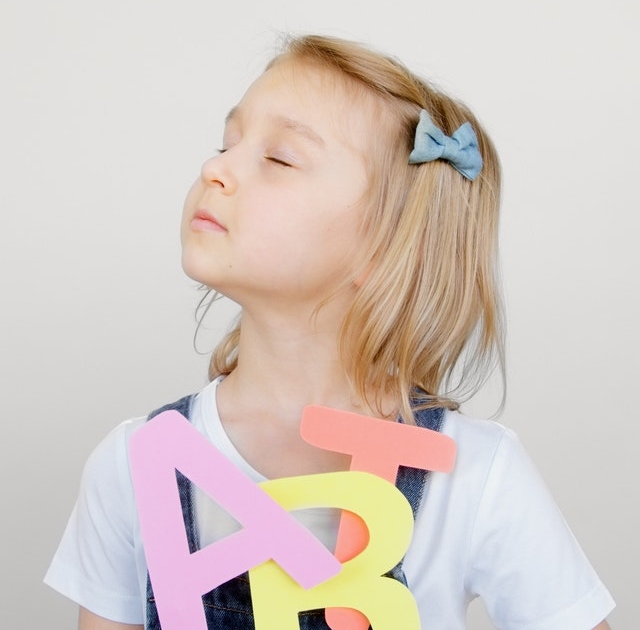
Participation in the arts are a way for someone to express themselves. It creates a window into the soul and an escape all in one. Some turn to painting, drawing, music, drama, or dancing to find their sense of self or to relieve stress after a long day, and this is no different for kids and adults with Cerebral Palsy (CP). Taking part in the arts is a wonderful thing for children with CP to do, no matter their level of disability, and here’s why!
Self Expression Without Limits
The arts allow for a place to explore what you are thinking or feeling. Whether you are verbal or non-verbal, participation in an art form is a way to get your feelings out! Society often tries to put us in boxes that may make us feel limited. But when you are creating art, you get to make the rules. Bend the rules to work for you
Adaptability
With the free form nature of many arts programs there are no rules that have to be adjusted to make it work for your body. If your dancing includes, moving your head side to side to make your wheelchair turn to the right and the left, do it! If you need something to secure a paint brush to one of your hands or to your head to paint your beautiful picture, why not! It’s your masterpiece, so the environment can be set up to make creating your art that much easier.
Community OR Solitary Art
Many arts are performed in a group setting for those who love being social, like Drama. You can find your Drama, Dance, or Visual Arts community if that floats your boat. BUT the cool thing about the arts is many forms don’t have to be done in a group, they can be done alone too if you’d prefer to work that way.
Confidence Booster
For many kids and adults, taking part in the creation of something beautiful, or something they made themselves, is a huge confidence booster. When the right adaptations are in place to support each child or adult, either with motor or intellectual considerations, the child can make something by themselves (or with a little bit of teamwork if needed) and feel proud of themselves for doing so!
Types of Art
Visual Arts
Dance
Drama
Music
But where is there to go in NJ for my child with CP to participate in the arts? Check out these links to find out more!
Dance:
http://kayelynndance.com/chance-to-dance/
http://www.danceinnovations.org/dipf
http://kayelynndance.com/chance-to-dance/
http://www.danceinnovations.org/dipf
Theater:
https://papermill.org/access-for-all
Art:
Music:
https://www.theconnectiononline.org/com
References:
https://www.cerebralpalsy.org/information/activities/arts
Children with cerebral palsy (CP) undergo intervention throughout their lives. They often receive physical therapy, occupational therapy, and speech therapy for many years in the home, school and clinic settings. Parents are often presented with lots of opinions as to therapy options, medical interventions like botox and baclofen, bracing options, and surgical procedures, such as selective dorsal rhizotomy and lengthening procedures.
Although it is a lot to navigate, parents, you need to know that you are the experts in your children, there is not doubt about that. Many parents will tell me that they feel like they are left to manage their child’s care in a world that speaks a different language that are all giving different opinions. This is not easy! That’s why when we provide care for our families, our goal is to help you manage the big picture and not only provide your child’s therapy. We’re here to support you, guide you, and connect you with resources every step of the way.
In the therapy world, there are so many different treatment approaches out there and often they are filled with big promises. This can add to the challenge of navigating the best care for your child. We know that you want the best for your child and we want to empower you to trust your gut, combined with learning as much as you can, to find the best match of services for your child.
TMR is a treatment approach that can be powerful for children with CP. Rather than tell you so, or even show you someone else’s child, I invite you to come in for a Discovery Visit at our practice to learn how TMR can help your child. TMR is integrated into our intensive therapy programs as well as our weekly sessions. It is an approach that is easily accessible for you to do at home in between sessions, which is a big piece of why it is so powerful- your repetition at home adds on to changes that are made in therapy sessions, stacking up to powerful changes in your child’s ability to breath, balance and move.
There is a reason families from around the world, from South Korea to Saudi Arabia, to throughout the United States, from NY, Virginia and Texas, have worked with us to learn how to use TMR to help their children breakthrough limits and open up new worlds of possibility.
Whether you’re curious or skeptical, we want to talk to you and share with you the future of pediatric therapy with children with CP and other movement disorders! Email us anytime at info@kidpt.com or call/text us at 908-543-4390.
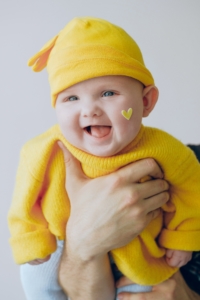
February is American Heart Month! Along with AHM, it is also Congenital Heart Defect Awareness Week from February 7th to February 14th! Many people don’t know, but children with Congenital Heart Defects (CHDs) often have to have surgery to correct the way their heart is working within their first year of life. Sometimes, depending on the severity, children with CHDs need multiple surgeries spanning from a couple of months after birth to their toddler years. Many of these surgeries cause children to stay immobile as they recover, which is necessary, but often limits their overall motor development. As most surgeries are performed within the child’s first year of life, these children can become delayed in crucial developmental milestones that would be occurring at this time.
This causes these kiddos to have to play a lot of catch up as they grow and develop as older infants, toddlers, in grade school, and beyond. Understandably, if you are a parent of a child with a CHD, you may have felt overwhelmed when your child was going through struggles and surgeries. We have heard from our parents, many are just so relieved when their child begins to recover from surgery, and starts to move around and play again.
Often, physical therapy for children with CHD’s is crucial to make up for lost time, improve gross motor skills, and catch them up to where they have the potential to be! Sometimes the importance of physical therapy is overlooked as they have other medical based needs to meet, but their success with movement is also very important to their success in life, in play, and in school later on!
Having children with a history of a CHD screened by a physical therapist, and if appropriate started in physical therapy services is important to do ASAP. If you have a child who recently had surgery and still has mobility restrictions, check with their heart surgeon to see if it is okay to start PT, and they will give you the go ahead when they think your child is ready and cleared to move.
We understand how scary it can be to encourage your child to move and play after hearing so much “don’t do this” or “no they can’t do that right now” that typically comes right before and after surgery. If you aren’t sure where to start, let us PTs help you! We know how to encourage the development of new motor skills and play while keeping in mind any restrictions that your child still has, to help them be the best that they can be while making sure they stay as safe as they can be. The best part is, we can coach you how to do similar activities at home so that you know how to keep your child safe, but help them grow while they play at home.
Basically, we are here to be your teammate, parents! We know the road you have traveled with your child has been tough, and you may or may not have some more road left to go. But regardless of the difficulty of the journey, we are here to support you and your child along the way to make life easier for you and to help your child achieve all the motor skills they are capable of (while having fun)!
Reference:
Sprong, M. C., Broeders, W., van der Net, J., Breur, J. M., de Vries, L. S., Slieker, M. G., & van Brussel, M. (2021). Motor developmental delay after cardiac surgery in children with a critical congenital heart defect: A systematic literature review and meta-analysis.
